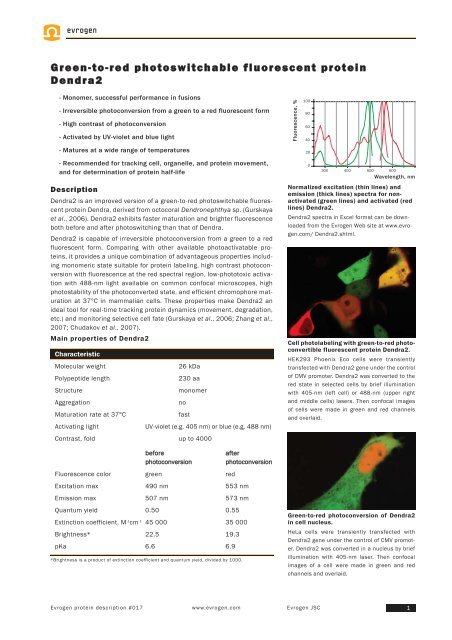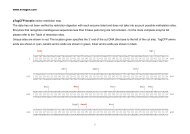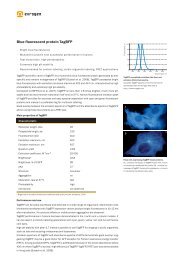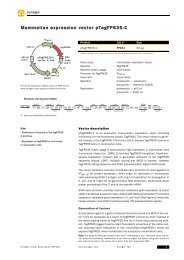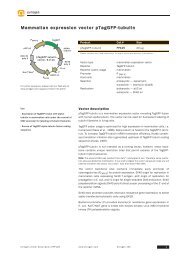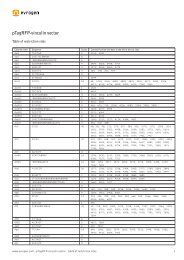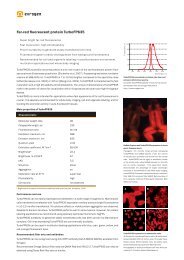Green to red photoswitchable fluorescent protein Dendra2 - Evrogen
Green to red photoswitchable fluorescent protein Dendra2 - Evrogen
Green to red photoswitchable fluorescent protein Dendra2 - Evrogen
Create successful ePaper yourself
Turn your PDF publications into a flip-book with our unique Google optimized e-Paper software.
G r e e n - t o - r e d p h o t o s w i t c h a b l e f l u o r e s c e n t p r o t e i n<br />
D e n d r a 2<br />
- Monomer, successful performance in fusions<br />
- Irreversible pho<strong>to</strong>conversion from a green <strong>to</strong> a <strong>red</strong> <strong>fluorescent</strong> form<br />
- High contrast of pho<strong>to</strong>conversion<br />
- Activated by UV-violet and blue light<br />
- Matures at a wide range of temperatures<br />
Fluorescence, %<br />
100<br />
80<br />
60<br />
40<br />
20<br />
- Recommended for tracking cell, organelle, and <strong>protein</strong> movement,<br />
and for determination of <strong>protein</strong> half-life<br />
Description<br />
<strong>Dendra2</strong> is an improved version of a green-<strong>to</strong>-<strong>red</strong> pho<strong>to</strong>switchable <strong>fluorescent</strong><br />
<strong>protein</strong> Dendra, derived from oc<strong>to</strong>coral Dendronephthya sp. (Gurskaya<br />
et al., 2006). <strong>Dendra2</strong> exhibits faster maturation and brighter fluorescence<br />
both before and after pho<strong>to</strong>switching than that of Dendra.<br />
<strong>Dendra2</strong> is capable of irreversible pho<strong>to</strong>conversion from a green <strong>to</strong> a <strong>red</strong><br />
<strong>fluorescent</strong> form. Comparing with other available pho<strong>to</strong>activatable <strong>protein</strong>s,<br />
it provides a unique combination of advantageous properties including<br />
monomeric state suitable for <strong>protein</strong> labeling, high contrast pho<strong>to</strong>conversion<br />
with fluorescence at the <strong>red</strong> spectral region, low-pho<strong>to</strong><strong>to</strong>xic activation<br />
with 488-nm light available on common confocal microscopes, high<br />
pho<strong>to</strong>stability of the pho<strong>to</strong>converted state, and efficient chromophore maturation<br />
at 37°C in mammalian cells. These properties make <strong>Dendra2</strong> an<br />
ideal <strong>to</strong>ol for real-time tracking <strong>protein</strong> dynamics (movement, degradation,<br />
etc.) and moni<strong>to</strong>ring selective cell fate (Gurskaya et al., 2006; Zhang et al.,<br />
2007; Chudakov et al., 2007).<br />
Main properties of <strong>Dendra2</strong><br />
Characteristic<br />
Molecular weight<br />
26 kDa<br />
Polypeptide length<br />
230 aa<br />
Structure<br />
monomer<br />
Aggregation<br />
no<br />
Maturation rate at 37°C<br />
fast<br />
Activating light<br />
UV-violet (e.g. 405 nm) or blue (e.g. 488 nm)<br />
Contrast, fold up <strong>to</strong> 4000<br />
before<br />
after<br />
pho<strong>to</strong>conversion<br />
pho<strong>to</strong>conversion<br />
Fluorescence color green <strong>red</strong><br />
Excitation max 490 nm 553 nm<br />
Emission max 507 nm 573 nm<br />
Quantum yield 0.50 0.55<br />
Extinction coefficient, M -1 cm -1 45 000 35 000<br />
Brightness* 22.5 19.3<br />
pKa 6.6 6.9<br />
*Brightness is a product of extinction coefficient and quantum yield, divided by 1000.<br />
0<br />
300 400 500 600<br />
Wavelength, nm<br />
Normalized excitation (thin lines) and<br />
emission (thick lines) spectra for nonactivated<br />
(green lines) and activated (<strong>red</strong><br />
lines) <strong>Dendra2</strong>.<br />
<strong>Dendra2</strong> spectra in Excel format can be downloaded<br />
from the <strong>Evrogen</strong> Web site at www.evrogen.com/<br />
<strong>Dendra2</strong>.shtml.<br />
Cell pho<strong>to</strong>labeling with green-<strong>to</strong>-<strong>red</strong> pho<strong>to</strong>convertible<br />
<strong>fluorescent</strong> <strong>protein</strong> <strong>Dendra2</strong>.<br />
HEK293 Phoenix Eco cells were transiently<br />
transfected with <strong>Dendra2</strong> gene under the control<br />
of CMV promoter. <strong>Dendra2</strong> was converted <strong>to</strong> the<br />
<strong>red</strong> state in selected cells by brief illumination<br />
with 405-nm (left cell) or 488-nm (upper right<br />
and middle cells) lasers. Then confocal images<br />
of cells were made in green and <strong>red</strong> channels<br />
and overlaid.<br />
<strong>Green</strong>-<strong>to</strong>-<strong>red</strong> pho<strong>to</strong>conversion of <strong>Dendra2</strong><br />
in cell nucleus.<br />
HeLa cells were transiently transfected with<br />
<strong>Dendra2</strong> gene under the control of CMV promoter.<br />
<strong>Dendra2</strong> was converted in a nucleus by brief<br />
illumination with 405-nm laser. Then confocal<br />
images of a cell were made in green and <strong>red</strong><br />
channels and overlaid.<br />
<strong>Evrogen</strong> <strong>protein</strong> description #017 www.evrogen.com <strong>Evrogen</strong> JSC 1
Available variants and fusions<br />
Dendra is a mutant of the GFP-like <strong>protein</strong> from oc<strong>to</strong>coral Dendronephthya<br />
sp. (Gurskaya et al., 2006). Compa<strong>red</strong> with Dendra, <strong>Dendra2</strong> comprises<br />
single A224V substitution, which results in better maturation and a brighter<br />
fluorescence both before and after pho<strong>to</strong>switching.<br />
<strong>Dendra2</strong> codon usage is optimized for high expression in mammalian cells<br />
(Haas et al., 1996), but it can be successfully expressed in many other heterological<br />
systems.<br />
<strong>Dendra2</strong>-At variant<br />
<strong>Dendra2</strong>-At codon usage is optimized for high expression in Arabidopsis.<br />
This variant is available in Gateway® entry clones.<br />
Performance and use<br />
A<br />
C<br />
B<br />
D<br />
<strong>Dendra2</strong> efficiently matures both at 20°C and 37°C, which makes possible<br />
the use of the <strong>protein</strong> in wide range of experimental systems, from cultu<strong>red</strong><br />
mammalian cells <strong>to</strong> cold-blooded animals. Mammalian cells transiently<br />
transfected with <strong>Dendra2</strong> expression vec<strong>to</strong>rs display an evenly distributed<br />
green signal without aggregation within 10-12 hrs after transfection. No<br />
cell <strong>to</strong>xicity is observed. High pho<strong>to</strong>stability of pho<strong>to</strong>converted <strong>Dendra2</strong><br />
(more than 3 times higher than of DsRed) makes it particularly useful for<br />
long-term <strong>protein</strong> tracking applications.<br />
<strong>Dendra2</strong> successful performance has been proven in many fusions including<br />
that with cy<strong>to</strong>plasmic beta-actin, BH3 interacting domain death agonist<br />
(BID), nucleolar <strong>protein</strong> fibrillarin, vimentin, and alpha-tubulin.<br />
High contrast of pho<strong>to</strong>conversion: In response <strong>to</strong> intense 405 nm or 488<br />
nm light irradiation, <strong>Dendra2</strong> undergoes irreversible pho<strong>to</strong>conversion<br />
expressed in a decrease in green and appearance of <strong>red</strong> fluorescence. After<br />
complete pho<strong>to</strong>conversion, <strong>red</strong> fluorescence of <strong>Dendra2</strong> increases more<br />
than 150-300 times, whereas the level of green fluorescence becomes<br />
more than 10-15 times lower. Thus, the increase in the <strong>red</strong>-<strong>to</strong>-green fluorescence<br />
ratio results in about a 4000-fold contrast. Considerable<br />
decrease of green fluorescence during <strong>Dendra2</strong> pho<strong>to</strong>conversion provides<br />
a molecular <strong>to</strong>ol <strong>to</strong> simultaneously track both the movement of the activated<br />
<strong>protein</strong> and its replacement with the non-activated form.<br />
<strong>Dendra2</strong> use for determination of <strong>protein</strong> half-life: In the method proposed,<br />
cells are transfected with a construct coding for target <strong>protein</strong> fused with a<br />
pho<strong>to</strong>switchable tag (PAFP). A steady-state concentration of the fusion <strong>protein</strong><br />
and corresponding <strong>fluorescent</strong> signal depends on <strong>protein</strong> synthesis and<br />
maturation rates as well as <strong>protein</strong> degradation rate. After pho<strong>to</strong>conversion<br />
of the pho<strong>to</strong>switchable tag in a whole cell, a pool of distinct <strong>fluorescent</strong> molecules<br />
appears, which is independent of the synthesis and maturation of the<br />
new PAFP molecules. Thus, the decay of the activated fluorescence directly<br />
corresponds <strong>to</strong> the degradation of the PAFP-tagged <strong>protein</strong>. Time-lapse<br />
imaging of the activated signal allows for quantification of degradation<br />
process in real-time at the single cell level (Zhang et al., 2007).<br />
To test the applicability of <strong>Dendra2</strong> for determination of <strong>protein</strong> half-life, it<br />
was fused with IkappaB-alpha <strong>protein</strong>, having well-characterized decay in<br />
cells. Cells with moderate expression levels of IkappaB-alpha-<strong>Dendra2</strong><br />
demonstrated the expected, p<strong>red</strong>ominantly cy<strong>to</strong>plasmic, localization of<br />
green fluorescence. After pho<strong>to</strong>conversion, time-lapse series showed fast<br />
decay of the <strong>red</strong> signal with a half-life of 1.5-2 hrs. The addition of a proteasome<br />
inhibi<strong>to</strong>r immediately terminated <strong>red</strong> fluorescence decay. Thus,<br />
the decrease of <strong>red</strong> <strong>fluorescent</strong> signal was caused by proteasomal degradation<br />
of the fusion <strong>protein</strong>. The rate of <strong>red</strong> signal decay was in good agreement<br />
with the available data on the half-life of IkappaB-alpha obtained<br />
using cycloheximide chase. It has been shown earlier that the phorbol<br />
ester, phorbol 12-myristate 13-acetate (PMA), increases the IkappaB-alpha<br />
E<br />
Labeling of intracellular <strong>protein</strong>s with<br />
<strong>Dendra2</strong>.<br />
Confocal images of HeLa cells transiently<br />
expressing <strong>Dendra2</strong>-tagged <strong>protein</strong>s: A, B —<br />
beta-actin; C — vimentin; D, E — alpha-tubulin;<br />
F — fibrillarin. Scale bar, 10 μm.<br />
Normalized <strong>red</strong> fluorescence<br />
1.0<br />
0.8<br />
0.6<br />
0.4<br />
0.2<br />
0<br />
0 20<br />
PMA<br />
F<br />
40 60 80 100 120<br />
Time, min<br />
Moni<strong>to</strong>ring <strong>protein</strong> degradation using<br />
<strong>Dendra2</strong> pho<strong>to</strong>conversion.<br />
Graphs show time course of <strong>red</strong> fluorescence<br />
change in HEK293 Phoenix Eco cells after<br />
<strong>Dendra2</strong> pho<strong>to</strong>conversion by blue light. Each line<br />
corresponds <strong>to</strong> a representative individual cell<br />
(10-15 cells were measu<strong>red</strong> for each experiment).<br />
The cells were transiently transfected<br />
with: <strong>Dendra2</strong> (green) or IkappaB-alpha-<br />
<strong>Dendra2</strong> (resting cells — <strong>red</strong>; cells treated with<br />
phorbol 12-myristate 13-acetate (PMA, 0.1<br />
μg/ml) at a time point designated by blue arrow<br />
— blue). <strong>Dendra2</strong> along demonstrates practically<br />
no decay, IkappaB-alpha-<strong>Dendra2</strong> has a halflife<br />
of 1.5-2 hrs in resting cells and 20 min after<br />
stimulation with PMA.<br />
<strong>Evrogen</strong> <strong>protein</strong> description #017 www.evrogen.com <strong>Evrogen</strong> JSC 2
degradation rate. Indeed, a considerable acceleration of <strong>red</strong> fluorescence<br />
decay after cell treatment with PMA was detected using pho<strong>to</strong>activation of<br />
IkappaB-alpha-<strong>Dendra2</strong> (Zhang et al., 2007).<br />
Recommended antibodies, filter sets, and visualization<br />
parameters<br />
Antibodies<br />
<strong>Dendra2</strong> can be recognized using <strong>Evrogen</strong> Anti-<strong>Dendra2</strong> antibody (Cat.#<br />
AB821-AB822).<br />
Primary <strong>Dendra2</strong> visualization<br />
Non-activated <strong>Dendra2</strong> possesses excitation-emission maxima at 490 and<br />
507 nm, similarly <strong>to</strong> EGFP and other green <strong>fluorescent</strong> <strong>protein</strong>s. Thus, commonly<br />
used fluorescence filter sets for EGFP, FITC, and other green dyes<br />
(e.g. Omega Optical QMAX-<strong>Green</strong> and XF100-2) are ideally suitable for<br />
<strong>Dendra2</strong> green state.<br />
A unique feature of <strong>Dendra2</strong> is its pho<strong>to</strong>conversion <strong>to</strong> <strong>red</strong> <strong>fluorescent</strong> state<br />
in response <strong>to</strong> intense-blue-light irradiation at 460-500 nm. In other words,<br />
light of the same wavelength is requi<strong>red</strong> for both visualization and pho<strong>to</strong>conversion<br />
of <strong>Dendra2</strong>. Importantly, <strong>Dendra2</strong> pho<strong>to</strong>conversion occurs only<br />
at high light intensities, whereas <strong>Dendra2</strong> green fluorescence can be<br />
detected at low light intensities. You should carefully select conditions<br />
allowing <strong>to</strong> detect green signal without undesirable pho<strong>to</strong>conversion.<br />
Pho<strong>to</strong>activation of <strong>Dendra2</strong> and <strong>Dendra2</strong>-tagged <strong>protein</strong>s<br />
<strong>Dendra2</strong> can be pho<strong>to</strong>converted by light irradiation in either UV-violet (360-<br />
420 nm) or blue region (460-500 nm). We recommend that you use 405 nm<br />
diode laser or 488 nm Ar laser line. 405-nm laser provides more efficient<br />
pho<strong>to</strong>conversion compa<strong>red</strong> with 488-nm laser. However, intense UV-violet<br />
light can be harmful for cells.<br />
Tracking <strong>Dendra2</strong> and <strong>Dendra2</strong>-tagged <strong>protein</strong>s after activation<br />
Activated <strong>Dendra2</strong> <strong>protein</strong> possesses excitation/emission maxima at 553/<br />
573 nm. Thus, TRITC filter set or similar (e.g. Omega Optical QMAX-Yellow<br />
and XF108-2) can be used for activated <strong>Dendra2</strong> visualization. Under the<br />
confocal microscope, the <strong>red</strong> <strong>fluorescent</strong> signal can be acqui<strong>red</strong> using 543-<br />
nm excitation laser line and detected at 560-650 nm.<br />
beta-actin<br />
fibrillarin<br />
vimentin<br />
<strong>Green</strong><br />
Red<br />
<strong>Green</strong>-<strong>to</strong>-<strong>red</strong> pho<strong>to</strong>conversion of <strong>Dendra2</strong>-<br />
tagged <strong>protein</strong>s.<br />
HeLa cells were transiently transfected with vec<strong>to</strong>rs<br />
encoding <strong>Dendra2</strong>-tagged fusion <strong>protein</strong>s<br />
which was pho<strong>to</strong>converted in a selected region<br />
by 488-nm laser. Confocal images were made<br />
after pho<strong>to</strong>conversion in green and <strong>red</strong> channels.<br />
References<br />
Chudakov et al. (2007) Nat. Pro<strong>to</strong>cols 8: 2024-2032..<br />
Gurskaya et al. (2006) Nat. Biotechnol. 24(4):461-465.<br />
Haas et al. (1996) Curr. Biol. 6: 315–324.<br />
Zhang et al. (2007) BioTechniques 42:446-450.<br />
<strong>Evrogen</strong> <strong>protein</strong> description #017 www.evrogen.com <strong>Evrogen</strong> JSC 3
<strong>Dendra2</strong>-related products<br />
Product Cat.# Description Size<br />
<strong>Dendra2</strong> expression/source vec<strong>to</strong>rs<br />
p<strong>Dendra2</strong>-C* FP821 Mammalian expression vec<strong>to</strong>r encoding humanized 20 μg<br />
<strong>Dendra2</strong> and allowing <strong>Dendra2</strong> expression and<br />
generation of fusions <strong>to</strong> the <strong>Dendra2</strong> C-terminus<br />
p<strong>Dendra2</strong>-N* FP822 Mammalian expression vec<strong>to</strong>r encoding humanized 20 μg<br />
<strong>Dendra2</strong> and allowing <strong>Dendra2</strong> expression and<br />
generation of fusions <strong>to</strong> the <strong>Dendra2</strong> N-terminus<br />
p<strong>Dendra2</strong>-B FP823 Bacterial expression vec<strong>to</strong>r; source of the humanized 20 μg<br />
<strong>Dendra2</strong> coding sequence<br />
Gateway® FP824 Gateway® entry clone for generation of fusions 20 μg<br />
<strong>Dendra2</strong>-At-C<br />
<strong>to</strong> the C-terminus of Arabidopsis-optimized <strong>Dendra2</strong>;<br />
transfer of <strong>Dendra2</strong> or its fusion in<strong>to</strong> a Gateway®<br />
destination vec<strong>to</strong>r for expression in a desi<strong>red</strong><br />
heterological system<br />
Gateway® FP825 Gateway® entry clone for generation of fusions 20 μg<br />
<strong>Dendra2</strong>-At-N<br />
<strong>to</strong> the N-terminus of Arabidopsis-optimized <strong>Dendra2</strong>;<br />
transfer of <strong>Dendra2</strong> or its fusion in<strong>to</strong> a Gateway®<br />
destination vec<strong>to</strong>r for expression in a desi<strong>red</strong><br />
heterological system<br />
Recombinant <strong>protein</strong><br />
r<strong>Dendra2</strong> FP852 Purified recombinant green-<strong>to</strong>-<strong>red</strong> pho<strong>to</strong>switchable <strong>protein</strong> 100 μg<br />
Antibodies against <strong>Dendra2</strong><br />
Anti-<strong>Dendra2</strong> AB821 Rabbit polyclonal antibody against <strong>Dendra2</strong> 100 μg<br />
antibody AB822 200 μg<br />
Please contact your local distribu<strong>to</strong>r for exact prices and delivery information.<br />
Notice <strong>to</strong> Purchaser:<br />
<strong>Dendra2</strong>-related products are intended <strong>to</strong> be used by academic (non-commercial) entities and for research purposes only. Any use of the proprietary<br />
nucleic acid or <strong>protein</strong> other than for research use or by a commercial entity is strictly prohibited. Transfer of this product by purchaser <strong>to</strong> any other<br />
party is specifically prohibited.<br />
CMV Promoter: The CMV promoter is cove<strong>red</strong> under U.S. Patents 5,168,062 and 5,385,839, and its use is permitted for research purposes only. Any<br />
other use of the CMV promoter requires a license from the University of Iowa Research Foundation, 214 Technology Innovation Center, Iowa City, IA<br />
52242. Invitrogen Gateway® Technology: please see Limited Use Label License No. 19: Gateway® Cloning Products at www.evrogen.com/l3.shtml<br />
<strong>Evrogen</strong> <strong>protein</strong> description #017 www.evrogen.com <strong>Evrogen</strong> JSC 4


